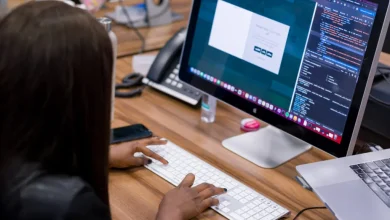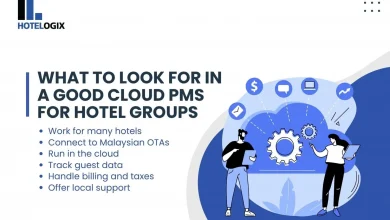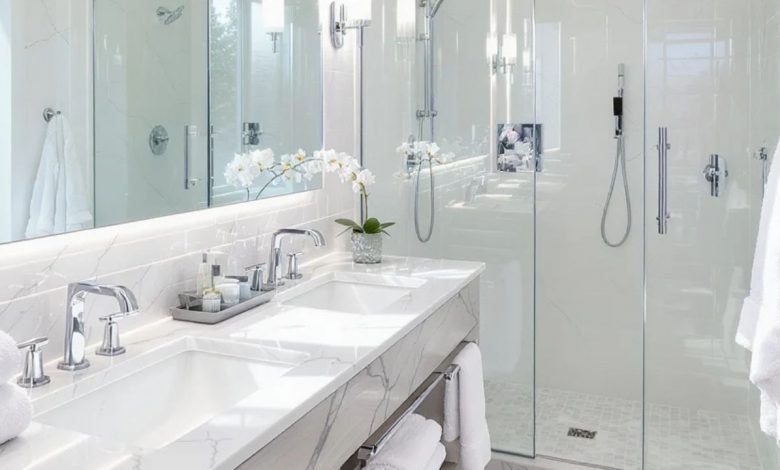
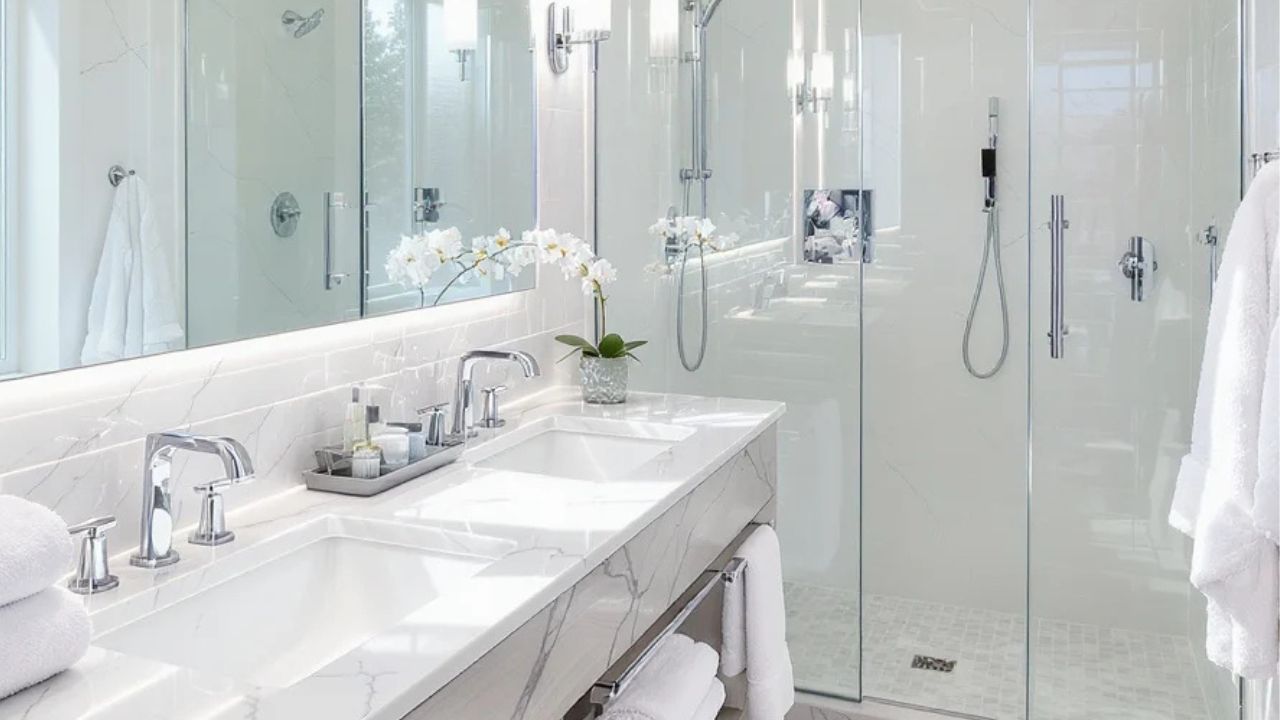
How clean are hotel bathrooms? Most are surface-cleaned daily, but true disinfection varies by brand, staffing, and products. High-touch spots—faucet handles, flush levers, light switches, door pulls, hair-dryer grips, and vanity edges—harbor the most germs. Look for dry, residue-free fixtures, fresh towels, and sealed cups.
Want a quick safety boost? Jump to the 2-minute hotel bathroom sanitizing routine, then come back to learn how to tell a quick wipe-down from real disinfection.
Hotel Bathroom Cleanliness Standards (What to Expect)
Most hotels clean and disinfect bathrooms between guests, but depth and consistency vary by brand, staffing, and products. Strong programs use color-coded microfiber, EPA-registered disinfectants, and documented checklists to reduce cross-contamination and focus on high-touch surfaces.
What top properties typically do
- Follow disinfectant contact (dwell) times per label
- Use separate cloths for toilets vs. sinks/counters/mirrors
- Maintain room-by-room sanitation logs and periodic audits
- Train staff on PPE, chemical safety, and cross-contamination prevention
Guest cue: Corners and grout should be debris-free; fixtures dry and residue-free; glassware sealed or single-use.
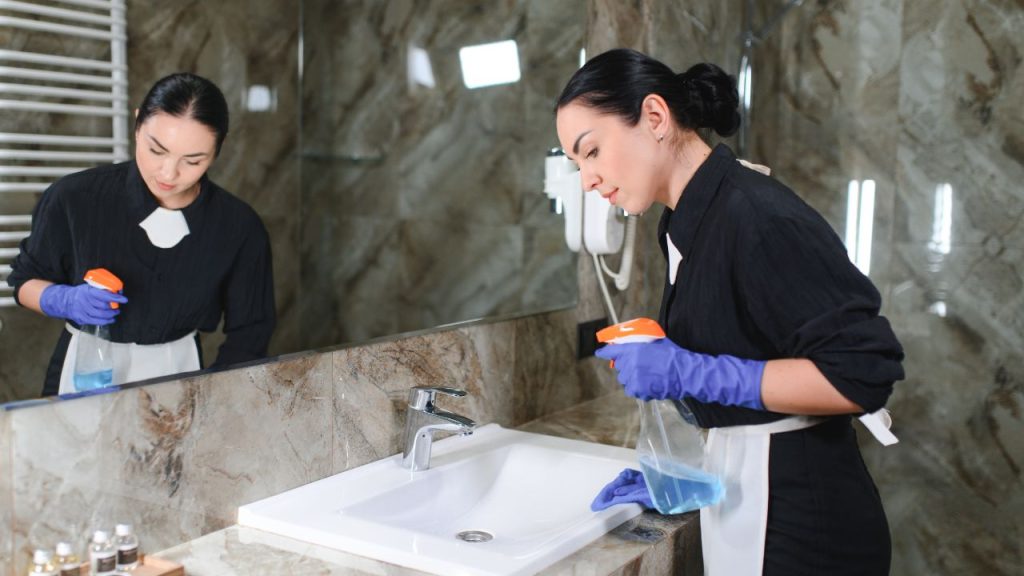
How Hotels Clean Bathrooms (Inside the Protocols)
Pre-clean prep
- PPE: fresh nitrile gloves per room; eye/respiratory protection as needed
- Reset: remove used linens and trash before spraying surfaces
- Scan: identify maintenance issues and any biohazards for safe handling
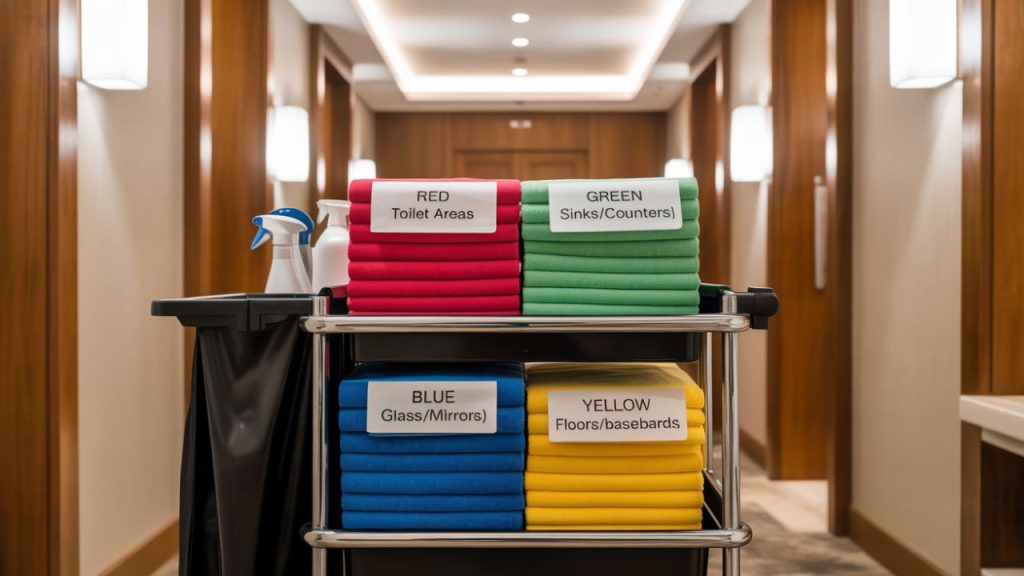
Tools & products that matter
- Color-coded microfiber: Red (toilet areas), Green (sinks/counters), Blue (glass/mirrors), Yellow (floors/baseboards)
- Right product, right surface: neutral cleaners for glossy tile; longer contact-time disinfectant for high-touch points
- Ventilation on: fan during and after cleaning to cut odors and moisture
Guest tip: Strong chemical smell doesn’t equal “clean.” Neutral scent and streak-free finishes are better indicators.
How to Evaluate Cleanliness on Arrival
- Touch test: faucet handles, flush lever, light switch, and door pull should feel clean, not tacky
- Mirror check: no spray haze or splatter
- Grout & corners: no buildup, hair, or soap scum
- Toilet base & hinges: clean where porcelain meets floor; hinges wiped
- Shower & glass: tracks clear; floor not slick; curtain/liner looks fresh
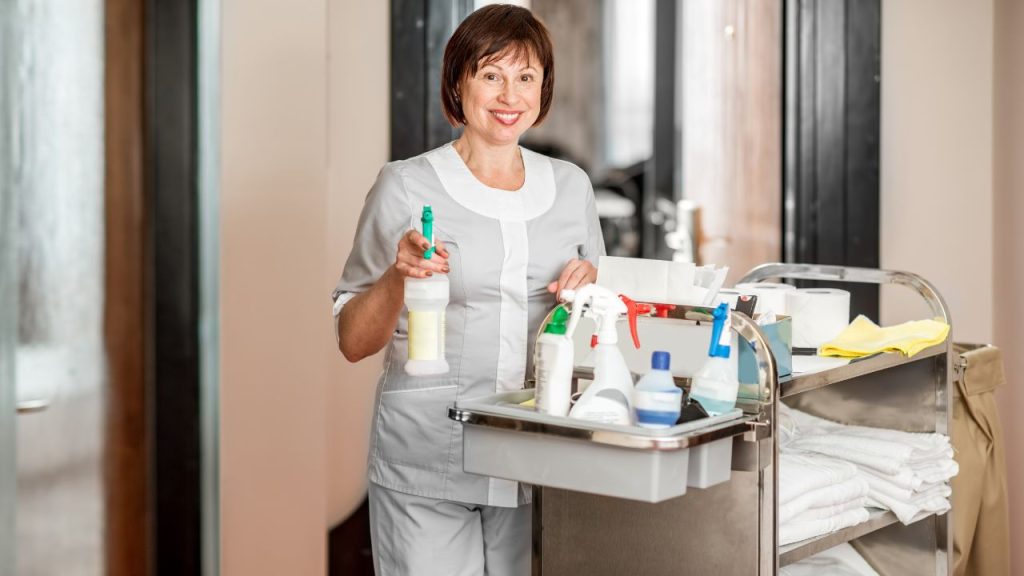
Signs of a Thorough Clean (What “Good” Looks Like)
- Neutral scent—not heavy fragrance masking moisture
- Sealed cups or wrapped glasses; fresh liners
- Dry fixtures & floors; no residue on counter edges
- Crisp grout/caulk without discoloration or peeling
Pro Methods You Might Notice
Tile, grout, and ceramic
- Apply cleaner, allow contact time, then agitate with the correct brush
- Use pH-appropriate formulas (neutral for glossy tile; foaming for textured surfaces)
Toilets & showers
- Treat bowl, seat/hinges, and exterior as separate zones
- Descale showerheads; squeegee or treat doors to prevent spotting
Fast fix for guests: If anything seems questionable, a quick wipe of 8–10 touchpoints with a travel disinfectant delivers the best ROI.
Ventilation & Moisture Control (Your Hidden Ally)
Run the bathroom fan during showers and for a short period after to lower humidity, discourage mold, and keep surfaces drier between housekeeping cycles. If there’s a window or dehumidifier, use it.
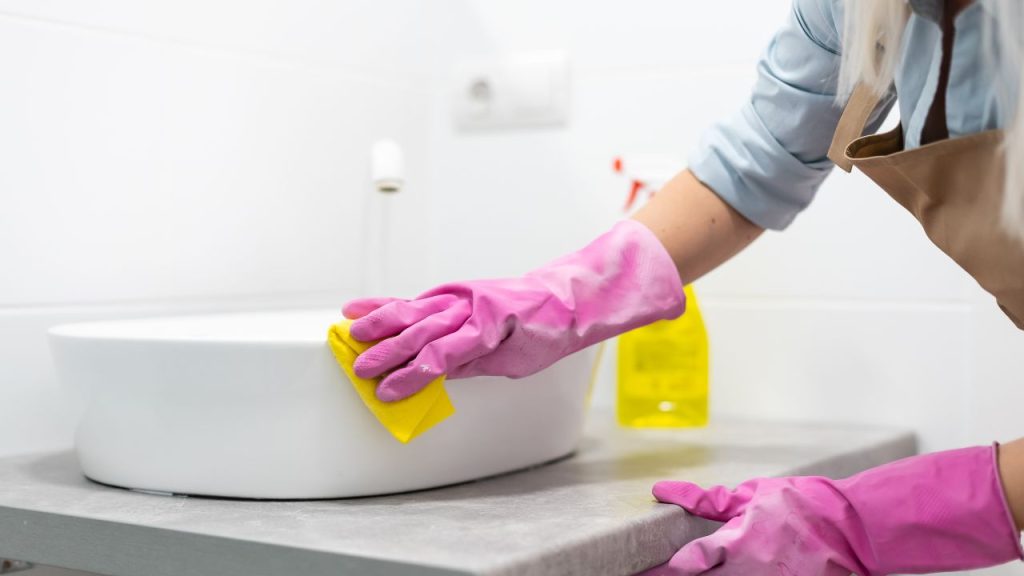
10-Point Arrival Audit
- Faucet handles
- Flush lever & seat hinges
- Light switch & door handle
- Counter edges & vanity hardware
- Hair-dryer handle
- Shower controls & door/curtain edge
- Shower track/threshold
- Toilet base where it meets the floor
- Mirror (streak check)
- Vent/fan functioning
2-Minute Hotel Bathroom Sanitizing Routine
This fast routine targets the highest-touch spots so you can feel confident about how clean your hotel bathroom is—without doing a full deep clean.
What you need
- 1–2 EPA List N disinfectant wipes or a travel-size disinfectant spray + tissues/paper towel
- Clean hand towel (to create a “landing zone” on the counter)
- Prep (0:00–0:20): Wash hands. Turn on the bathroom fan (or crack the door). Lay a clean towel on part of the counter as your landing zone.
- Non-toilet touchpoints (0:20–1:20): Using one wipe (or sprayed tissue), work clean → dirty in this order: door handle, light switch, counter edge, faucet handles, hair-dryer grip, shower control/door or curtain edge. Keep surfaces visibly wet.
- Toilet touchpoints (1:20–1:50): Switch to a fresh wipe/tissue. Wipe the flush lever, then the seat (top and underside) and outer lid. Avoid the bowl rim unless you have another wipe.
- Finish (1:50–2:00): Leave surfaces wet for label contact time (often 30–60 seconds). Dispose wipes in the trash (do not flush). Wash hands again.
Safety notes: Don’t mix products; avoid spraying into outlets; spot-test natural stone (use non-bleach products). Strong fragrance ≠ cleaner—neutral scent and streak-free finishes are better signs.
FAQ – How Clean Are Hotel Bathrooms?
Should you tip hotel housekeeping?
In the U.S., tipping hotel housekeeping is customary (not mandatory)—including during day use hotel stays. We advocate tipping—see why tipping hotel housekeeping matters. As a rule of thumb:
Abroad: check local norms; some places include service charges.
$2–$5 per night for a standard room
$5–$10+ per night for suites, extra guests, or heavy use
Tip daily (staff rotate)
Leave cash with a short note: “Housekeeping—thank you.”
Do hotels just wing it with cleaning, or is there a rulebook?
Most follow strict protocols set by health boards or brands, using checklists, EPA-approved disinfectants, and color-coded tools to avoid cross-contamination.
How can you tell if that “fresh scent” is hiding a germ party?
Check corners for grime, shower doors for streaks, and tile grout for suspicious discoloration. If the trash bin’s empty but the floor feels sticky, someone might’ve skipped the encore scrub.
What’s the deal with ventilation in guest spaces?
Proper airflow reduces moisture, which means fewer mold raves and musty odors. If the fan sounds like a jet engine, let it roar, it’s saving you from science experiments in the shower.
Are those fancy cleaning products just for show?
Pros swear by hospital-grade disinfectants for toilets and hydrogen peroxide for mirrors. But if you spot a rainbow of microfiber cloths, they’re not decorating, they’re ensuring your sink doesn’t get wiped with toilet germs.
Should you trust the “sanitized” seal on the toilet?
Treat it as a signal, not proof. A seal means the bathroom was serviced after the last stay, but it isn’t a lab certificate. Trust—but verify:
- Do a 10-second check: seat (top/underside), hinges, flush lever, and the base where porcelain meets the floor. Surfaces should look dry, streak-free, and residue-free.
- Peace-of-mind wipe: hit the flush lever and seat (top and underside) with a disinfectant wipe; let surfaces stay wet for the label contact time, then toss the wipe in the trash and wash your hands.
- If anything looks off: request a re-clean or a new room.
(And skip flushing wipes or mixing cleaning products.)


